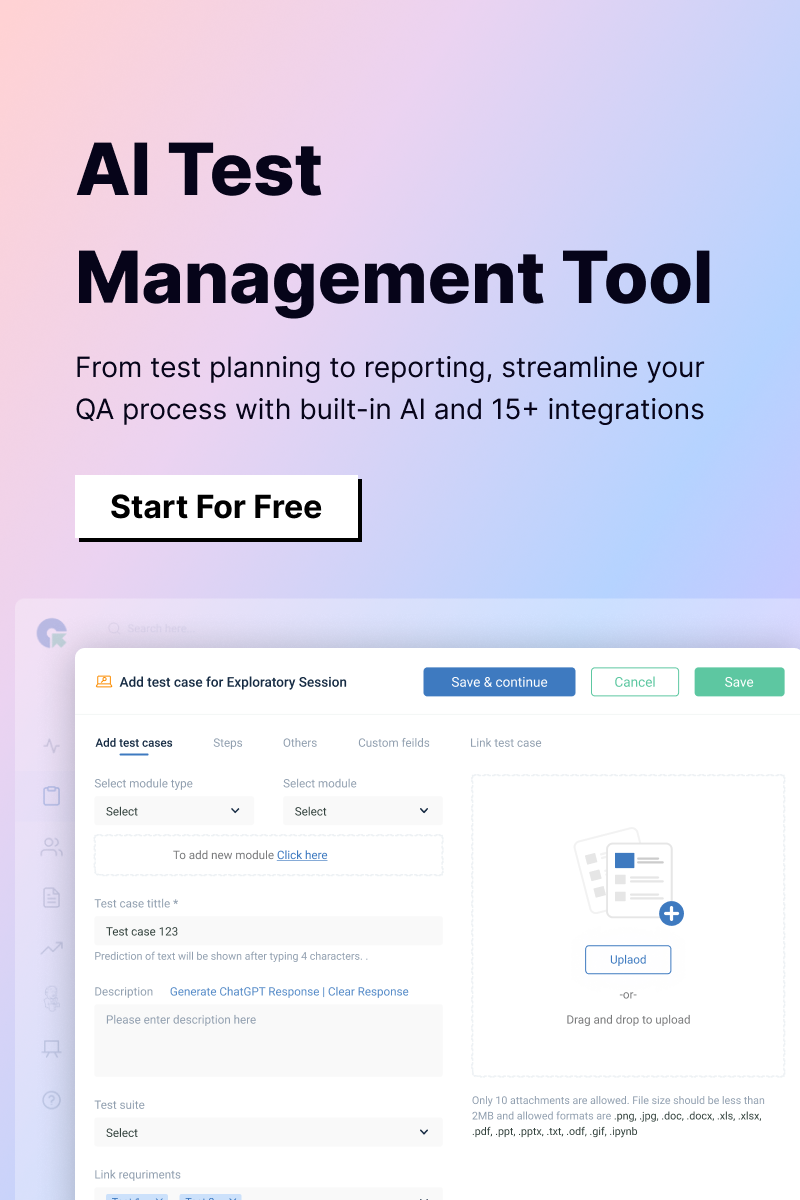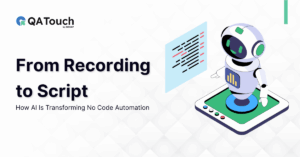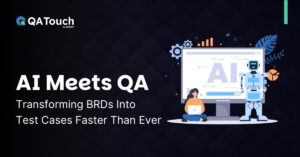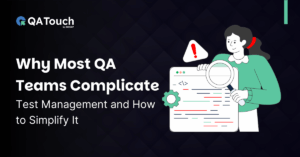AI-Augmented Testing: What It Is and Why It Matters
Software quality has become a defining factor for success in the fast-moving Agile and DevOps environments. With the growing complexity and higher expectations for reliability, teams are releasing updates faster than ever.
For QA teams, this creates a challenge- how to keep pace with the fast development while ensuring that nothing slips through the cracks. Over the years, testing has evolved to meet this challenge, moving from manual testing, to automation, and now to an even smarter adaptive approach- AI-Augmented Testing.
AI-Augmented Testing doesn’t just automate what testers do; it enhances their work. By analyzing patterns, predicting risks, adapting to change, and providing actionable insights, AI helps testers focus on what they do best, critical thinking, creativity, and ensuring customer satisfaction. In this blog, let us understand AI-Augmented testing in detail, its benefits and more.
What is AI-Augmented Testing?
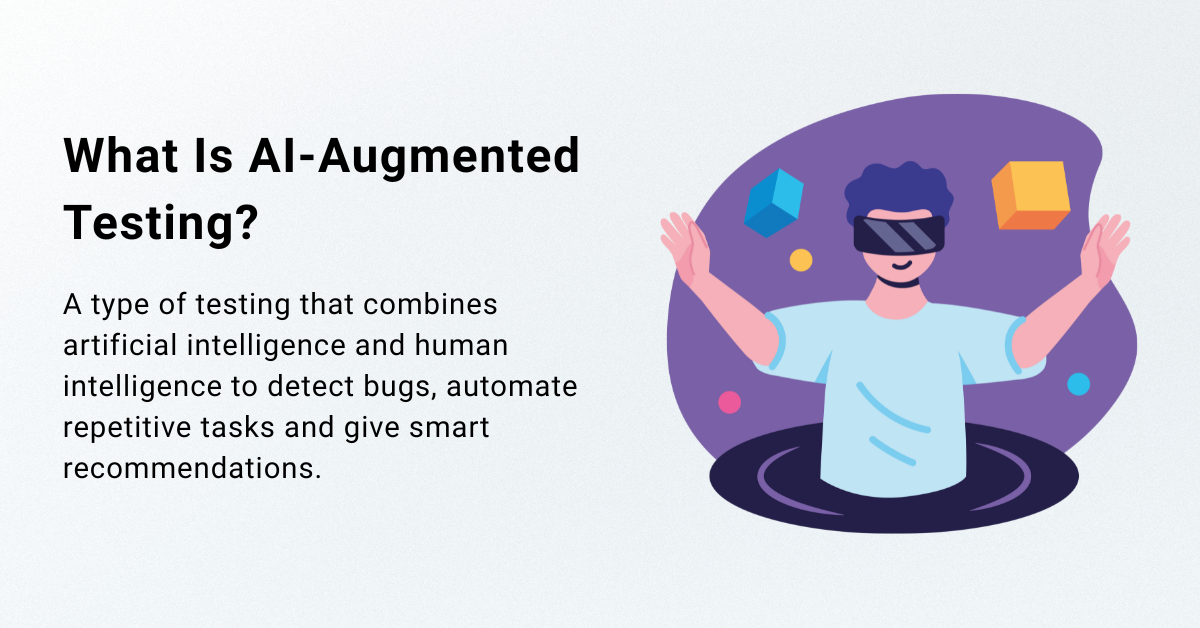
AI-Augmented Testing is a modern approach to software testing where artificial intelligence helps testers by automating repetitive tasks, spotting patterns in data, and giving smart recommendations, while testers remain in control of the process.
The main goal of AI-Augmented Testing is to improve speed, accuracy, and test coverage, not to replace human testers. It allows QA teams to focus on meaningful, high-value work, while AI handles routine and data-heavy tasks.
When to Use AI-Augmented Testing?
AI-Augmented Testing is especially useful in situations like these:
- When you have large test suites that are time-consuming and difficult to maintain
- When your application undergoes frequent UI changes, which can break traditional automated tests.
- When working in Agile or CI/CD pipelines, where fast, reliable feedback is critical for continuous delivery.
Features of AI-Augmented Testing
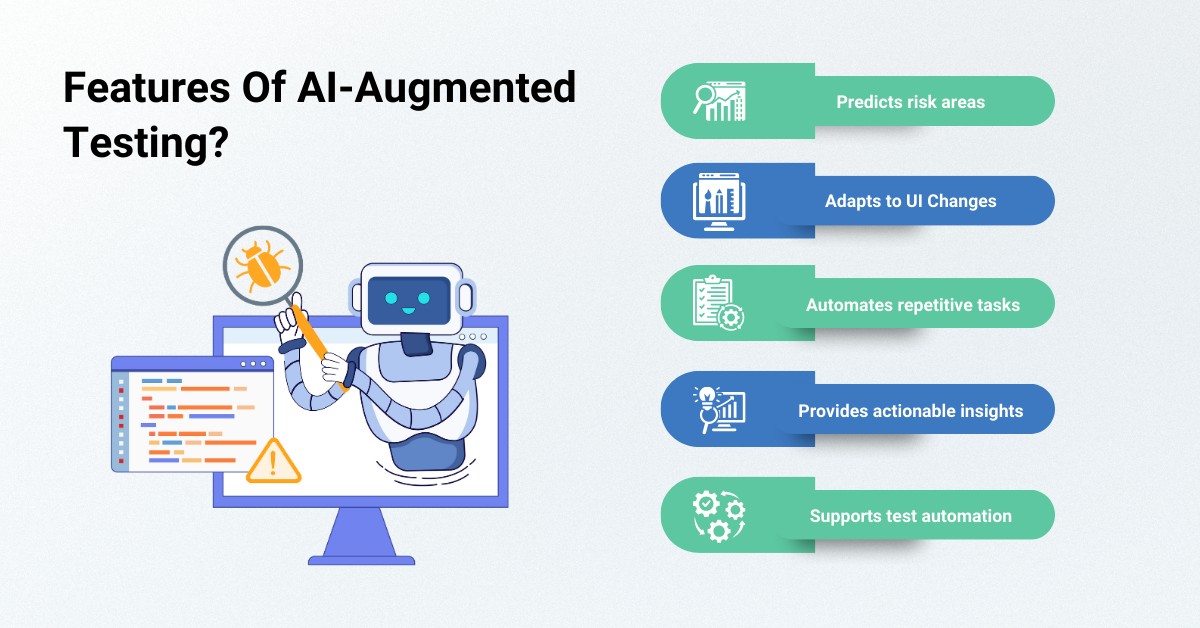 Here are some of the key features of AI-Augmented Testing:
Here are some of the key features of AI-Augmented Testing:
Learns from past defects and predicts risk areas
AI analyzes previous bugs and test results to identify patterns. This helps testers focus on high-risk areas where failures are more likely.
Adapts to UI changes and minimizes flaky tests
When the user interface changes, AI detects and adjusts to those changes. This reduces the number of failed tests caused by minor UI updates.
Automates repetitive, low-value tasks
Tasks like executing regression tests or creating test data are automated by AI. This saves time and lets testers focus on more complex scenarios.
Provides actionable insights from analytics
AI reviews test and defect data to generate clear, useful insights. These insights help teams understand project health, risks, and coverage gaps.
Supports test automation and maintenance
AI keeps automated test scripts aligned with application changes. This cuts down on maintenance work and keeps tests reliable over time.
How AI Enhances Traditional Testing Workflows
AI significantly improves traditional testing workflows by making them more intelligent, adaptive, and efficient. Here’s a closer look at the key areas where AI adds value:
Smarter Test Case Generation & Prioritization
AI can analyze application requirements, historical defect data, and usage analytics to automatically suggest test cases that cover the most critical functionality. It also helps prioritize which tests to run first based on risk and impact, ensuring that high-value areas are tested early and thoroughly.
Bug Prediction & Defect Clustering
By learning from past defect logs, AI can predict which areas of the application are most prone to bugs and alert testers to focus on those. It also groups related defects into meaningful clusters, making it easier for teams to identify root causes and address issues efficiently.
Automated Test Maintenance
One of the biggest challenges in traditional test automation is keeping tests updated when the application changes. AI solves this by detecting UI or code changes and updating test scripts automatically, which greatly reduces flaky tests and maintenance overhead.
Intelligent Analytics & Reporting
AI-powered analytics go beyond simple pass/fail metrics. They provide deep insights into project health, test coverage gaps, defect trends, and potential risk areas. These intelligent reports help QA teams make informed decisions quickly and communicate effectively with stakeholders.
QA Touch’s AI-Augmented Testing Features
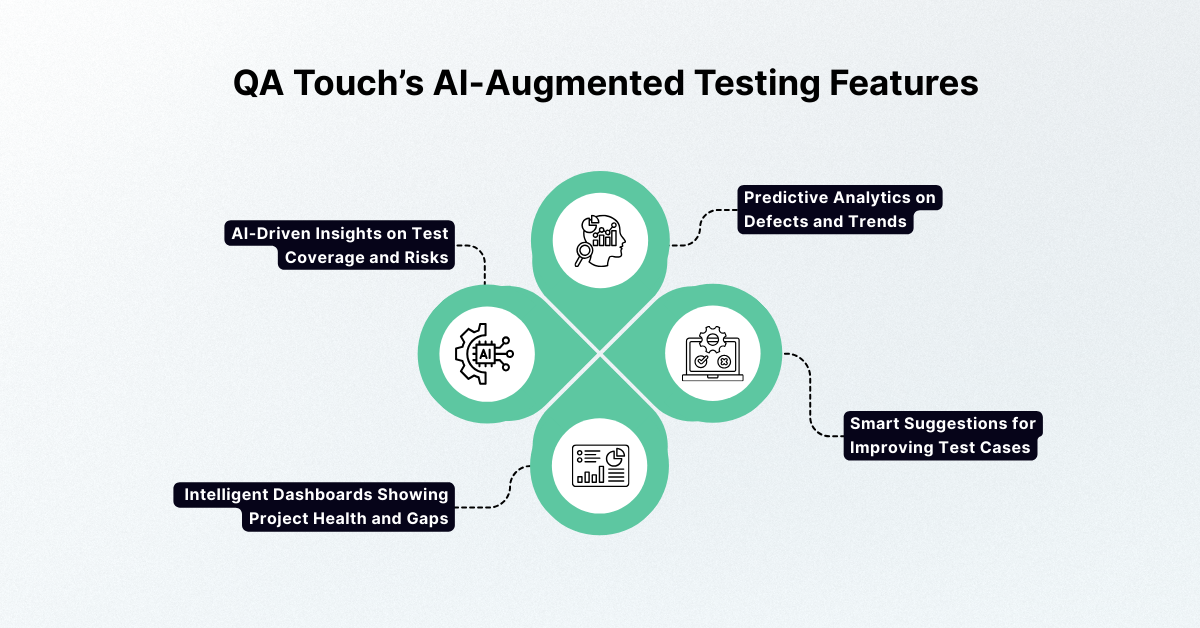
As a QA tester, managing large test suites, tracking risks, and keeping the testing process efficient can be overwhelming. That’s where QA Touch steps in with AI-powered features designed to help you work smarter and stay on top of your testing goals. Here’s a detailed look at how QA Touch supports you with AI:
AI-Powered Test Case Writing
Writing test cases manually can be time consuming, repetitive and prone to errors. With QA Touch’s AI-powered test case generation feature, you can create accurate, well-structured test cases in just a few clicks. You no longer need to spend hours filling out spreadsheets or rewriting the same scenarios.
AI Chatbot For Faster Solutions
Testing is not just about executing scripts; it also requires clear and timely communication with your team and customers. QA Touch’s AI-powered chatbot is designed to handle queries instantly and keep conversations flowing smoothly at any time of day. It enables you to respond quickly, improve collaboration, and ensure everyone stays informed, all without placing additional burden on your team.
Simplify BDD With AI-Generated Scripts
Understanding the importance of bridging the gap between technical and non-technical team members is crucial when testing. With QA Touch’s AI-powered BDD script generation, you can transform user stories into clear, easy-to-understand scenarios written in Gherkin syntax. This makes collaboration simpler and ensures that everyone, from developers to business stakeholders, shares a common understanding of how the application should behave.
Manage Everything in One Unified Platform
There is no need to juggle multiple tools for project management, test management, bug tracking, and timesheet tracking. QA Touch enables you to manage all of these processes in one place, reducing complexity and allowing you to focus on delivering quality software. By combining AI-powered features with a smooth workflow, QA Touch empowers you and your team to test smarter, collaborate more effectively, and release faster.
Real-world Applications of AI-Augmented Testing
AI-Augmented Testing is no longer just a concept; it’s actively being used across many industries to improve software quality and speed up delivery. Here are some key areas where AI-powered testing is making a real difference:
Banking & FinTech Applications
Financial applications require strict accuracy, security, and compliance. AI-Augmented Testing assists in analyzing large volumes of transaction data, predicting potential risk areas, and maintaining automated tests that keep up with frequent regulatory updates. This helps banks and FinTech firms deliver secure, reliable software with faster release cycles.
Healthcare Software
Healthcare systems manage sensitive patient data and often have complex workflows. AI supports QA teams by automating repetitive tasks, adapting tests to evolving user interfaces, and providing insights into risk areas. This helps ensure critical healthcare applications are safe, reliable, and compliant with industry standards.
Large-scale Enterprise Systems
Enterprise software is often complex, with many integrated modules and frequent updates. AI helps manage the complexity by prioritizing tests based on risk, automatically maintaining test scripts, and providing analytics on defects and coverage. This allows enterprises to maintain high quality while accelerating delivery in fast-paced environments.
Techniques to perform AI-Augmented Testing
If you’re wondering how AI actually helps improve testing, it’s all about the smart techniques working behind the scenes. Here are some of the key AI methods you’ll find powering AI-Augmented Testing:
- Pattern Recognition in Defect Logs
AI scans through your past bug reports and test results to find common patterns. This helps you spot recurring issues faster and focus your testing on problem areas that matter most. - Machine Learning on Historical Test Data
By learning from the results of previous tests, AI can predict which tests are more likely to catch defects. This means you can prioritize those tests and get quicker feedback on your software quality. - Natural Language Processing (NLP) for Requirements Analysis
AI uses NLP to understand written requirements, user stories, or test cases. This helps in automatically identifying gaps or inconsistencies and even suggests relevant test cases, saving you time in test planning. - Predictive Analytics for Defect Trends
AI looks at historical defect data and uses predictive models to forecast where new bugs might appear. This allows you to be proactive, addressing risks before they turn into bigger problems.
Common Myths about AI-Augmented Testing
There’s a lot of talk about AI in testing, and some of it can be misleading. Let’s clear up a few common myths you might have heard:
Myth: AI replaces testers.
The truth is, AI is here to help you, not replace you. It takes care of repetitive and time-consuming tasks, but human insight and judgment remain essential for making smart decisions and understanding complex issues.
Myth: AI testing is only for big enterprises.
AI-powered testing tools are becoming more accessible for teams of all sizes. Whether you’re part of a small startup or a large corporation, you can benefit from AI to improve efficiency and test quality.
Myth: AI delivers perfect results automatically.
AI is a powerful assistant, but it’s not magic. It depends on good data, proper setup, and your expertise to interpret and guide its recommendations. Think of AI as a tool that boosts your work, not one that does it all flawlessly on its own.
Best Practices for AI-Augmented Testing
To truly benefit from AI in your testing process, it’s important to use it wisely. Here are some best practices that can help you get the most out of AI-powered testing:
- Don’t try to use every AI feature at once. Begin with a few key areas where AI can help the most, learn from the experience, and then expand its use as you grow comfortable.
- AI is a powerful tool, but it works best when paired with your knowledge and judgment. Use AI to handle repetitive tasks and analyze data, while you focus on interpreting results and making decisions.
- AI improves with good input. Make sure to feed your AI models accurate, relevant data regularly. This keeps its predictions and suggestions reliable and useful.
- Don’t just accept AI suggestions blindly. Review them carefully, validate what makes sense, and adjust your testing strategies accordingly to get the best outcomes.
Conclusion
AI-Augmented Testing is transforming how QA teams work, helping them test smarter, faster, and more effectively. With a test management platform like QA Touch, you can utilize AI to improve your testing processes, reduce maintenance, and deliver higher-quality software.
Ready to see how AI can elevate your QA process? Sign up on QA Touch today and start your AI-powered testing journey.
FAQ
What is augmented AI?
Augmented AI refers to the collaboration between humans and artificial intelligence, where AI supports and enhances human tasks rather than replacing them. It helps by automating repetitive work and providing smart insights, while humans make the final decisions. This approach aims to boost productivity and accuracy across various fields.
What is the AI-augmented testing tool?
An AI-augmented testing tool is software that utilises artificial intelligence to assist QA testers. It automates routine testing tasks, analyses past test and defect data, predicts risk areas, and provides actionable insights. This helps teams test faster, reduce errors, and improve software quality without compromising human oversight.
How can AI be used for testing?
AI can be applied in testing by generating and prioritizing test cases based on data patterns, identifying recurring defects, and maintaining test scripts automatically as applications change. It also provides predictive analytics to forecast potential risks and gaps, enabling testers to focus on the most critical areas and improve overall efficiency.



